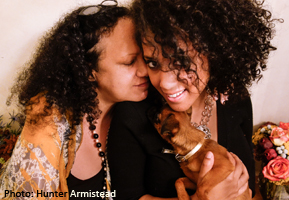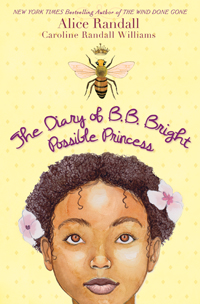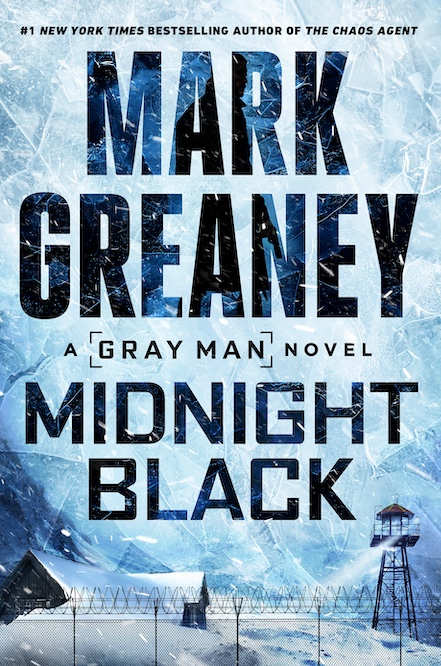Renovating the Fairy Tale
Mother-daughter duo Alice Randall and Caroline Randall Williams talk with Chapter 16 about fairy tales, writing across generational lines, and their new children’s novel, The Diary of B.B. Bright, Possible Princess
In their first co-written children’s novel, The Diary of B.B. Bright, Possible Princess, The New York Times best-selling author and Vanderbilt University Writer-in-Residence Alice Randall and her daughter Caroline Randall Williams, who is currently earning her MFA at the University of Mississippi, joined forces to create a fairytale-rich world featuring a modern young heroine.
In the magical lands of B.B. Bright, rules abound. B.B., thirteen, is an orphaned princess in hiding. She lives under rules that govern everything from how far she can travel and who can set foot on her island to which words she can speak aloud about her secret royal identity. Told in B.B.’s own voice, the novel follows B.B.’s determination to navigate these rules, to understand the women around her, and ultimately to understand her own strengths well enough to gain her freedom in the larger world.
Randall and Williams jointly answered questions via email from Chapter 16:
Chapter 16: Many mothers and daughters would have serious trepidation about writing a book as a team. How did this collaboration develop?
 Randall and Williams: Very naturally. Over time. Decades. Literally. First it was a story spoken and told. Eventually it became written and read. We moved from riffing off of each other to editing each other. We spent five years in a mother-daughter book group. One of Caroline’s earliest birthday parties was a three day make-a-book party that involved making paper—with a blender—writing poems, editing poems, and a cake decorated with an open book made out of icing. For us co-writing seems, somehow, inevitable.
Randall and Williams: Very naturally. Over time. Decades. Literally. First it was a story spoken and told. Eventually it became written and read. We moved from riffing off of each other to editing each other. We spent five years in a mother-daughter book group. One of Caroline’s earliest birthday parties was a three day make-a-book party that involved making paper—with a blender—writing poems, editing poems, and a cake decorated with an open book made out of icing. For us co-writing seems, somehow, inevitable.
Chapter 16: B.B. Bright begins her diary by saying, “I want off this island”—a recognizable, possibly universal, lament of adolescents. But B.B. is also a gutsy, industrious girl who is willing to work for the freedom she craves. How did she come into focus as a character?
Randall and Williams: B.B. has Caroline’s personality! This is a fantasy novel with strong autobiographical/biographical elements.
Chapter 16: B.B. lives on Bee Isle with her three Godmommies—G. Mama Dot, a former bus driver with a lyrical swing in her speech; Godmother Elizabethanne, former lawyer and a formidable chess partner; and Godmommy Grace, former preacher who teaches B.B. to relax with yoga. Were there specific inspirations for these delightful women?
Randall and Williams: Absolutely. But we can’t tell you who they are because there are several people who think they are G. Mama Dot, and more than one sure she’s Godmother Elizabethanne, and a dozen hoping to be claimed as Godmommy Grace! What we can say is the idea of having godmommies who are hyper-influential came from Alice’s godmother, Godmommy Lea (Leatrice McKissack) and Caroline’s godmother, Mama-Mimi (Mimi Oka)
Chapter 16: Throughout the book, women often challenge each other across generational lines, keeping one another in check. Did any parallel dynamics occur between the two of you as you wrote?
Randall and Williams: Absolutely. One of us can make everything too intellectual if given free reign. One of us can get things a little too wild. Together the book is wild enough and smart enough—but not too wild or wordy.
Chapter 16: Were there things each of you learned about the other in writing this book that surprised you?
 Randall and Williams: We learned we could form a seamless alliance. We do bicker. In the kitchen. Out shopping. Discussing the news of the day. Writing, peace descended. That’s how we got the idea for B.B.’s candles. The way we feel writing together is the way people feel in the glow of her candlelight.
Randall and Williams: We learned we could form a seamless alliance. We do bicker. In the kitchen. Out shopping. Discussing the news of the day. Writing, peace descended. That’s how we got the idea for B.B.’s candles. The way we feel writing together is the way people feel in the glow of her candlelight.
Chapter 16: B.B. is a modern girl even as she is surrounded by classic fairy-tale elements. It’s necessary to walk a fine line in order to construct a story that honors traditional fairy-tale structures and imagery, yet still feels modern. Was this a conscious balance you tried to strike?
Randall and Williams: We were consciously interested in integrating the specific world of fairy tales that so dominates American little-girl world. To that end we desired to create a classic fairytale princess inhabiting a world of ideal magic and beauty and power. But we also wished to renovate the architecture of the old stories, staying true to the essential elements, but providing new colors—significant new details and new themes. We sought to privilege the future over the past with our renovations. We wished to center our fairytale in the timeless and psychological, not in the political and medieval. Caroline loved Catherine, Called Birdy [by Karen Cushman], a novel that strikes this balance. Alice has long been interested in psychoanalytic interpretations of fairy tales. Early on we settled on creating a world that inhabits a space that suggests the fragments of a dream breaking into fresh awakening.
Chapter 16: After her thirteenth birthday, B.B. strikes out alone, crossing Bee Isle to find the mysterious Eight Princesses and to learn about her mother, from whom she’s been separated for years. How do you hope B.B.’s journey will resonate with young readers who are puzzling out their own quests?
Randall and Williams: We hope B.B.’s adventure will embolden young readers to treasure their senses, their intellect, their creativity, their ability to nurture, their ability to lead, their spirituality, and their willingness to be an environmental champion, and their beauty. We think all girls have these gifts and knowing and claiming these gifts is a tremendous source of power.
Chapter 16: What’s this we hear about a nine-book deal with Turner?
Randall and Williams: Four different princesses—each with two books of her own—and a B.B. Bright picture book. We’re going to be busy for a very long time. The next princess in our series has a Chinese background. We’ve already begun the research.





